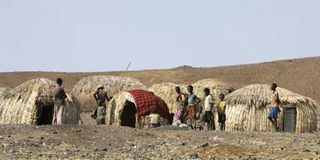Politics, not pathogens, drives spread of illness

El Molo villagers stand outside their shelters at Loiyangalani village in northeastern Kenya. Neglected health services, as well as governments who pursue development strategies that undermine the rural and urban poor, have compromised responses to disease outbreaks. PHOTO | FILE
What you need to know:
- Citing three such diseases – Rift Valley fever in Kenya, Trypanosomiasis in Zimbabwe and Ebola in West Africa, the paper states that these diseases are driven by factors other than the usual biotic factors.
- For the mosquito-transmitted Rift Valley fever, Dr Bukachi traces the historical link between the punitive ways in which the Kenyan government treated the former North-eastern province, to the losses that the area suffered due to Rift Valley fever (RVF).
- Globally, diseases have emerged or come back in more lethal forms than before, and the World Health Organisation estimates that seven in every 10 of the diseases that shake public health systems are zoonotic.
Belonging to certain political groups, and not exposure to disease-causing pathogens, makes people vulnerable to zoonotic diseases – the lethal diseases that human beings contract from animals.
This is the argument advanced by six researchers, including Kenya’s Dr Salome Bukachi, a medical anthropologist at the University of Nairobi, in a paper published in Royal Society earlier this month.
Citing three such diseases – Rift Valley fever in Kenya, Trypanosomiasis in Zimbabwe and Ebola in West Africa, the paper states that these diseases are driven by factors other than the usual biotic factors.
Neglected health services and growing gaps between elites and the underprivileged, as well as governments who pursue development strategies that undermine the rural and urban poor, have compromised responses to disease outbreaks.
Investments in dam infrastructure and the expansion of commercial farming in Zimbabwe, for instance, pushed populations into increasingly marginal spaces that are prone to outbreaks, with disease risks exacerbated by commercial interests in wildlife hunting.
For the mosquito-transmitted Rift Valley fever, Dr Bukachi traces the historical link between the punitive ways in which the Kenyan government treated the former North-eastern province, to the losses that the area suffered due to Rift Valley fever (RVF).
RIGHT CONDITIONS
There were two Rift Valley fever outbreaks between 1997 and 1998 as well as 2006 to 2007, with the epicentre in the northeast of the country, where poverty levels are estimated at seven in 10 of the entire population.
The 1997 outbreak is considered the most devastating where 27,500 infections occurred in Garissa, the largest ever recorded outbreak of RVF in East Africa.
Hundreds of people and livestock died, while others lost their livelihoods. Earlier on, North-eastern had been put under martial law until 1982, and during this time entry into the region was restricted, causing marginalisation and underdevelopment that had ripple effects on health.
Even in 2017, there are roads that are impassable especially when it rains, a period when RVF transmission is at its peak. This cuts medical attention to people and animals, making disease control extremely difficult.
“Pathogens are not sufficient causes of disease on their own,” says Dr Bukachi, adding that the socio-cultural, economic and political environment also plays a role in providing the right conditions to perpetuate the occurrence of disease”
In the paper titled ‘Local disease eco-system livelihood dynamics: Reflections from the comparative case studies in Africa’, Dr Bukachi demonstrates how political marginalisation, conflict and selective development “create ‘underlying generative structures’ of vulnerability.
During the research, Dr Bukachi came across farmers who said that they didn’t have a medical or veterinary officer or vaccines or pharmacies in their locality. Even where these healthcare workers were found, the numbers were too inadequate to meet the needs of the population.
Irrigation schemes initiated by government to help pastoralists diversify their incomes, ended up pushing the pastoralists to the tail ends of the water supply where stagnant water provided year-end cycles for mosquito breeding, and thus Rift Valley fever infection.
The perpetual conflict, from Al Shabab in Somalia and clan wars in the region, has not made things better.
This study reinforces emerging interest in the Kenyan epidemiological research circles on a new science discipline labelled One Health, where human health is perceived through the intersection of the environment and animals, and therefore calls for collective effort to manage it.
Globally, diseases have emerged or come back in more lethal forms than before, and the World Health Organisation estimates that seven in every 10 of the diseases that shake public health systems are zoonotic.
UNFAIR TREATMENT
In Kenya, the threat of diseases such as RVF led to the formation of the Zoonotic Disease Unit (ZDU) and technical working groups to respond to outbreaks.
However, research such as this shows not much has changed in the factors that drive the spread of diseases.
A paper published in March this year by the East African Institute showed that areas that have been historically in the opposition have the worst development indicators.
For instance, the report showed, eight per cent of people in Turkana have access to sanitation and hygiene while in Kiambu it is nearly 100 per cent.
The researchers note that not much has changed as the attitudes that dominated the unfair treatment of people in the past still exist.
______
Zoonotics:
Zoonosis refers to an infectious animal disease that can be transmitted to humans.
A zoonotic agent can be a bacterium, virus, fungus, or any other communicable disease agent.
Zoonoses include trypanosomiasis, ebola and Rift Valley fever (RVF). RVF was first identified in Kenya in 1931. It is a viral disease common in north-eastern Kenya and is usually transmitted by mosquitoes from ruminant livestock such as cattle, camels, sheep and goats.



